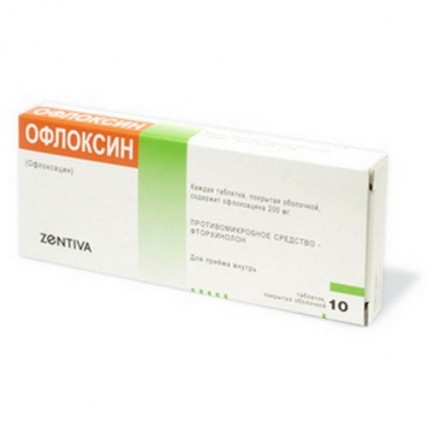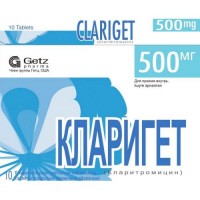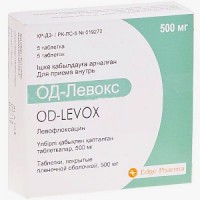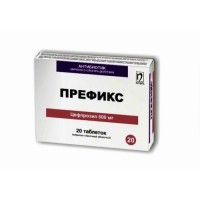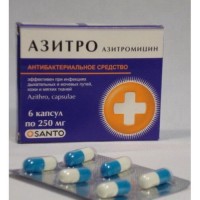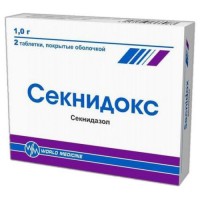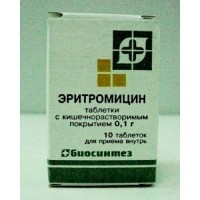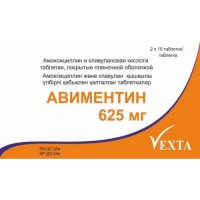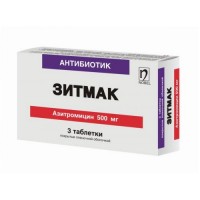Ofloksin 10s 200 mg coated tablets
- $14.90
The instruction for use
medicine for experts OFLOKSIN
the Trade name
Ofloksin
Mezhdunarodnoye the unlicensed
name Ofloxacin Dosage Form
of the Tablet, coated, 200 mg.
Structure
Active agent: ofloxacin - 200 mg.
Excipients for tabletting: lactoses monohydrate of 95.20 mg, corn starch of 47.60 mg, povidone of 25 - 12.00 mg, krospovidon 20.00 mg, half-oxameasures of 0.20 mg, magnesium stearate of 8.00 mg, talc of 4.00 mg,
Excipients for creation of a cover: a gipromelloza 2910/5 – 9.42 mg, makrogol 6000 - 0.53 mg, dioxide of the titan of 2.35 mg, talc of 0.70 mg
the Description
Round tablets of a biconvex form, coated white or almost white color, with dividing in half risky on one of the parties and an engraving 200 on another.
A look on a break: the pressed mass of white or almost white color.
Pharmacotherapeutic group
Antibacterial agent of group of ftorkhinolon
Code of automatic telephone exchange:
the Pharmacodynamics
Antimicrobial broad-spectrum agent from group of ftorkhinolon, affects bacterial DNK-girazu enzyme, the providing superspiralling and, thus, stability of DNA bacteria (destabilization of chains of DNA leads to their death). Renders bactericidal effect.
It is active concerning the microorganisms producing beta lactamelements and fast-growing atypical mycobacteria. Are sensitive: Staphylococcus aureus, Staphylococcus epidermidis, Neisseria gonorrhoeae, Neisseria meningitidis, Escherichia coli, Citrobacter, Klebsiella spp. (including Klebsiella pneumonia), Enterobacter spp., Hafnia, Proteus spp. (including Proteus mirabilis, Proteus vulgaris - an indole - positive and an indole - negative), Salmonella spp., Shigella spp. (including Shigella sonnei), Yersinia enterocolitica, Campilobacter jejuni, Aeromonas hydrophila, Plesiomonas aeruginosa, Vibrio cholerae, Vibrio parahaemolyticus, Haemophilus influenzae, Chlamydia spp., Legionella spp., Serratia spp., Providencia spp., Haemophilus ducreyi, Bordetella parapertussis, Bordetella pertussis, Moraxella catarrhalis, Propionibacterium acnes, Staphylococcus spp., Brucella spp.
Have various sensitivity to drug: Enterococcus faecalis, Streptococcus pyogenes, pneumoniae and viridans, Serratio marcescens, Pseudomonas aeruginosa, Acinetobacter, Mycoplasma hominis and pneumoniae, Mycobacterium tuberculosis and also Mycobacterium fortuim, Ureaplasma urealyticum, Clostridium perfringens, Corynebacterium spp., Helicobacter pylori, Listeria monocytogenes, Gardnerella vaginalis.
Are in most cases insensitive: Nocardia asteroides, anaerobic bacteria (for example, Bacteroides spp., Peptococcus spp., Peptostreptococcus spp., Eubacterium spp., Fusobacterium spp., Clostridium difficile).
Does not affect Treponema pallidum.
Pharmacokinetics
Absorption after intake fast and full (95%). Bioavailability - over 96%, communication with proteins of plasma – 25%, time of achievement of the maximum concentration (Tmax) at oral administration - 1-2 h, the maximum concentration (Cmax) after reception in a dose of 100 mg, 300 mg, 600 mg makes 1, 3, 4 and 6.9 mg/l. Food can slow down absorption, but has no significant effect on bioavailability.
The seeming distribution volume - 100 l. Distribution: cells (leukocytes, alveolar macrophages), skin, soft tissues, bones, abdominal organs and a small pelvis, the respiratory system, urine, saliva, bile, a prostate secret, well gets through a blood-brain barrier, a placental barrier, cosecretes with maternal milk. Gets into cerebrospinal fluid at the inflamed and uninflammed meninx (14-60%).
N-oxide of an ofloksatsin and dimethyl-ofloksatsina is metabolized in a liver (about 5%) with education. Elimination half-life – 4.5 - 7 h (irrespective of a dose). It is removed by kidneys - 75-90% (in not changed look), about 4% - with bile. Extrarenal clearance — less than 20%.
After single use in a dose of 200 mg in urine it is found during 20-24 h. In a renal/liver failure the removal can slow down. Does not kumulirut. At a hemodialysis 10-30% of drug are removed.
Indications
of Respiratory infection (bronchitis, pneumonia), ENT organs (sinusitis, pharyngitis, average otitis, laryngitis), skin, soft tissues, bones, joints, infectious and inflammatory diseases of an abdominal cavity and biliary tract (except for bacterial enteritis), kidneys (pyelonephritis), urinary tract (cystitis, an urethritis), bodies of a small pelvis (endometritis, a salpingitis, an oophoritis, a cervicitis, a parametritis, prostatitis), genitals (colpitis, an orchitis, an epididymite), gonorrhea, clamidiosis, a septicaemia (only for in/in introductions), meningitis, prevention of infections at patients with disturbance of the immune status (including at a neutropenia).
Route of administration and doses
Inside. Doses are selected individually depending on localization and weight of a course of an infection and also sensitivity of microorganisms, the general condition of the patient and function of a liver and kidneys.
The adult - on 200-800 mg a day, a course of treatment – 7 - 10 days, frequency rate of use – 2 times a day. It is possible to appoint a dose up to 400 mg a day in 1 reception, it is preferable in the morning.
In gonorrhea - 400 mg once.
At patients with renal failures (at clearance of creatinine of 50-20 ml/min.) the single dose has to make 50% of an average dose at frequency rate of appointment 2 times a day, or the full single dose is entered 1 time a day. At clearance of creatinine less than 20 ml/min. a single dose of-200 mg, then - on 100 mg a day every other day.
At a hemodialysis and peritoneal dialysis - on 100 mg each 24 h. The maximum daily dose in a liver failure - 400 mg/days.
A pill is taken entirely, washing down with water to or at meal time. Duration of a course of treatment is defined by sensitivity of the activator and a clinical picture, it is necessary to continue treatment at least 3 more days after disappearance of symptoms of a disease and full normalization of temperature. At treatment of salmonelloses a course of treatment – 7 - 8 days, in uncomplicated infections of the lower urinary tract a course of treatment – 3 - 5 days
Side effects
from digestive system: gastralgia, anorexia, nausea, vomiting, diarrhea, meteorism, abdominal pains, increase in activity of 'hepatic' transaminases, hyperbilirubinemia, cholestatic jaundice, pseudomembranous coloenteritis.
From nervous system: headache, dizziness, uncertainty of movements, tremor, spasms, numbness and paresthesias of extremities, intensive dreams, 'dreadful' dreams, psychotic reactions, uneasiness, condition of excitement, phobia, depression, confusion of consciousness, hallucination, increase in intracranial pressure.
From the musculoskeletal system: the tendinitis, myalgias, arthralgias, tendosinovit, a rupture of a sinew.
From sense bodys: disturbance of color perception, diplopia, disturbances of taste, sense of smell, hearing and balance.
From a cardiovascular system: tachycardia, lowering of arterial pressure, vasculitis, collapse.
Allergic reactions: skin rash, an itching, a small tortoiseshell, an allergic pneumonitis, allergic nephrite, an eosinophilia, fever, a Quincke's edema, a bronchospasm, Stephens's syndrome - Johnson and Layell, a photosensitization, a multiformny exudative erythema, an acute anaphylaxis.
From integuments: dot hemorrhages (petechias), dermatitis violent hemorrhagic, papular rash with a crust, confirming defeat of vessels (vasculitis).
From bodies of a hemopoiesis: leukopenia, agranulocytosis, anemia, thrombocytopenia, pancytopenia, hemolytic and aplastic anemia.
From an urinary system: acute interstitial nephrite, renal failure, giperkreatininemiya, increase in content of urea.
Other: dysbacteriosis, superinfection, a hypoglycemia (at patients with diabetes), a vaginitis.
Contraindications
· hypersensitivity,
· deficit glyukozo-6-fosfatdegidrogenazy,
· epilepsy (including in the anamnesis),
· decrease in a convulsive threshold (including after a craniocereberal injury, a stroke or inflammatory processes in the central nervous system),
· age up to 18 years (growth of a skeleton is not completed yet),
· pregnancy,
· lactation period.
With care - atherosclerosis of vessels of a brain, disturbance of cerebral circulation (in the anamnesis), chronic kidney disease, organic lesions of the central nervous system.
Medicinal interaction
the Foodstuff, antacids containing AI3+, Sa2+, Mg2 + or iron salts, reduce absorption of an ofloksatsin, forming insoluble complexes (time interval between prescribing of these drugs has to be not less than 2 h).
Reduces clearance of theophylline by 25% (at simultaneous use it is necessary to reduce a theophylline dose).
Cimetidinum, furosemide, a methotrexate and drugs blocking canalicular secretion - increase concentration of an ofloksatsin in plasma.
Increases concentration of glibenclamide in plasma.
At a concomitant use with antagonists of vitamin K it is necessary to exercise control of a coagulant system of blood.
When assigning with the non-steroidal anti-inflammatory drugs derivative of a nitroimidazole and methylxanthines the risk of development of neurotoxic effects increases.
At co-administration with glucocorticosteroids the risk of a rupture of sinews, especially at elderly people increases.
When assigning with the drugs alkalizing urine (karboangidraza inhibitors, citrates, sodium bicarbonate), the risk of a crystalluria and nephrotoxic effects increases.
Special instructions
is not choice drug in the pneumonia caused by pneumococci. Not shown at treatment of acute tonsillitis.
It is not recommended to apply more than 2 months, to be affected by sunshine, to uviolizing (mercury-quartz lamps, a sunbed).
In case of side effects from the central nervous system, allergic reactions, pseudomembranous colitis drug withdrawal is necessary. In the pseudomembranous colitis confirmed kolonoskopichesk and/or histologically the oral prescribing of Vancomycinum and metronidazole is shown.
Seldom arising tendinitis can lead to a rupture of sinews (mainly an Achilles tendon), especially at elderly patients. In case of symptoms of a tendinitis, it is necessary to stop immediately treatment, to make an immobilization of an Achilles tendon and to consult the orthopedist.
During treatment it is necessary to abstain from driving of motor transport and occupations potentially dangerous types of activity demanding the increased concentration of attention and speed of psychomotor reactions it is impossible to use ethanol.
At drug use the women are not recommended to use tampons, in connection with the increased risk of developing a thrush.
Against the background of treatment the deterioration in a course of a myasthenia, increase of attacks of a porphyria at predisposed patients is possible. Can result in false-negative results at bacteriological diagnosis of tuberculosis (interferes with Mycobacterium tuberculosis discharge).
At patients with abnormal liver functions or kidneys control of concentration of an ofloksatsin in plasma is necessary. In a heavy renal and liver failure the risk of development of toxic effects increases (dose adjustment is required).
At children it is applied only at threat of life taking into account expected advantage and potential risk of development of side effects when it is impossible to use other less toxic drugs. Average daily dose in this case-7.5 mg/kg, maximum-15 mg/kg.
Overdose
Symptoms: dizziness, confusion of consciousness, block, disorientation, drowsiness, vomiting.
Treatment: gastric lavage, symptomatic therapy. At a hemodialysis 10 – 30% of drug are removed.
Release form
On 7 or 10 tablets in the blister from aluminum foil / PVC-films. On 1 blister (10 tablets) or on 2 blisters (on 7 or 10 tablets) together with the instruction for use place in a cardboard pack
Storage conditions
the B List.
In the dry place, at a temperature from 10 of 0C up to 25 0C, inaccessible for children.
Expiration date
3 years. Not to use after expiry date.
Prescription status
According to the prescription.
The name and the address of the manufacturer
Zentiva of ampere-second., the Czech republic
At a kabelovna 130, Dolni Mekholupy Prague 10, 102 37
To develop
medicine for experts OFLOKSIN
the Trade name
Ofloksin
Mezhdunarodnoye the unlicensed
name Ofloxacin Dosage Form
of the Tablet, coated, 200 mg.
Structure
Active agent: ofloxacin - 200 mg.
Excipients for tabletting: lactoses monohydrate of 95.20 mg, corn starch of 47.60 mg, povidone of 25 - 12.00 mg, krospovidon 20.00 mg, half-oxameasures of 0.20 mg, magnesium stearate of 8.00 mg, talc of 4.00 mg,
Excipients for creation of a cover: a gipromelloza 2910/5 – 9.42 mg, makrogol 6000 - 0.53 mg, dioxide of the titan of 2.35 mg, talc of 0.70 mg
the Description
Round tablets of a biconvex form, coated white or almost white color, with dividing in half risky on one of the parties and an engraving 200 on another.
A look on a break: the pressed mass of white or almost white color.
Pharmacotherapeutic group
Antibacterial agent of group of ftorkhinolon
Code of automatic telephone exchange:
the Pharmacodynamics
Antimicrobial broad-spectrum agent from group of ftorkhinolon, affects bacterial DNK-girazu enzyme, the providing superspiralling and, thus, stability of DNA bacteria (destabilization of chains of DNA leads to their death). Renders bactericidal effect.
It is active concerning the microorganisms producing beta lactamelements and fast-growing atypical mycobacteria. Are sensitive: Staphylococcus aureus, Staphylococcus epidermidis, Neisseria gonorrhoeae, Neisseria meningitidis, Escherichia coli, Citrobacter, Klebsiella spp. (including Klebsiella pneumonia), Enterobacter spp., Hafnia, Proteus spp. (including Proteus mirabilis, Proteus vulgaris - an indole - positive and an indole - negative), Salmonella spp., Shigella spp. (including Shigella sonnei), Yersinia enterocolitica, Campilobacter jejuni, Aeromonas hydrophila, Plesiomonas aeruginosa, Vibrio cholerae, Vibrio parahaemolyticus, Haemophilus influenzae, Chlamydia spp., Legionella spp., Serratia spp., Providencia spp., Haemophilus ducreyi, Bordetella parapertussis, Bordetella pertussis, Moraxella catarrhalis, Propionibacterium acnes, Staphylococcus spp., Brucella spp.
Have various sensitivity to drug: Enterococcus faecalis, Streptococcus pyogenes, pneumoniae and viridans, Serratio marcescens, Pseudomonas aeruginosa, Acinetobacter, Mycoplasma hominis and pneumoniae, Mycobacterium tuberculosis and also Mycobacterium fortuim, Ureaplasma urealyticum, Clostridium perfringens, Corynebacterium spp., Helicobacter pylori, Listeria monocytogenes, Gardnerella vaginalis.
Are in most cases insensitive: Nocardia asteroides, anaerobic bacteria (for example, Bacteroides spp., Peptococcus spp., Peptostreptococcus spp., Eubacterium spp., Fusobacterium spp., Clostridium difficile).
Does not affect Treponema pallidum.
Pharmacokinetics
Absorption after intake fast and full (95%). Bioavailability - over 96%, communication with proteins of plasma – 25%, time of achievement of the maximum concentration (Tmax) at oral administration - 1-2 h, the maximum concentration (Cmax) after reception in a dose of 100 mg, 300 mg, 600 mg makes 1, 3, 4 and 6.9 mg/l. Food can slow down absorption, but has no significant effect on bioavailability.
The seeming distribution volume - 100 l. Distribution: cells (leukocytes, alveolar macrophages), skin, soft tissues, bones, abdominal organs and a small pelvis, the respiratory system, urine, saliva, bile, a prostate secret, well gets through a blood-brain barrier, a placental barrier, cosecretes with maternal milk. Gets into cerebrospinal fluid at the inflamed and uninflammed meninx (14-60%).
N-oxide of an ofloksatsin and dimethyl-ofloksatsina is metabolized in a liver (about 5%) with education. Elimination half-life – 4.5 - 7 h (irrespective of a dose). It is removed by kidneys - 75-90% (in not changed look), about 4% - with bile. Extrarenal clearance — less than 20%.
After single use in a dose of 200 mg in urine it is found during 20-24 h. In a renal/liver failure the removal can slow down. Does not kumulirut. At a hemodialysis 10-30% of drug are removed.
Indications
of Respiratory infection (bronchitis, pneumonia), ENT organs (sinusitis, pharyngitis, average otitis, laryngitis), skin, soft tissues, bones, joints, infectious and inflammatory diseases of an abdominal cavity and biliary tract (except for bacterial enteritis), kidneys (pyelonephritis), urinary tract (cystitis, an urethritis), bodies of a small pelvis (endometritis, a salpingitis, an oophoritis, a cervicitis, a parametritis, prostatitis), genitals (colpitis, an orchitis, an epididymite), gonorrhea, clamidiosis, a septicaemia (only for in/in introductions), meningitis, prevention of infections at patients with disturbance of the immune status (including at a neutropenia).
Route of administration and doses
Inside. Doses are selected individually depending on localization and weight of a course of an infection and also sensitivity of microorganisms, the general condition of the patient and function of a liver and kidneys.
The adult - on 200-800 mg a day, a course of treatment – 7 - 10 days, frequency rate of use – 2 times a day. It is possible to appoint a dose up to 400 mg a day in 1 reception, it is preferable in the morning.
In gonorrhea - 400 mg once.
At patients with renal failures (at clearance of creatinine of 50-20 ml/min.) the single dose has to make 50% of an average dose at frequency rate of appointment 2 times a day, or the full single dose is entered 1 time a day. At clearance of creatinine less than 20 ml/min. a single dose of-200 mg, then - on 100 mg a day every other day.
At a hemodialysis and peritoneal dialysis - on 100 mg each 24 h. The maximum daily dose in a liver failure - 400 mg/days.
A pill is taken entirely, washing down with water to or at meal time. Duration of a course of treatment is defined by sensitivity of the activator and a clinical picture, it is necessary to continue treatment at least 3 more days after disappearance of symptoms of a disease and full normalization of temperature. At treatment of salmonelloses a course of treatment – 7 - 8 days, in uncomplicated infections of the lower urinary tract a course of treatment – 3 - 5 days
Side effects
from digestive system: gastralgia, anorexia, nausea, vomiting, diarrhea, meteorism, abdominal pains, increase in activity of 'hepatic' transaminases, hyperbilirubinemia, cholestatic jaundice, pseudomembranous coloenteritis.
From nervous system: headache, dizziness, uncertainty of movements, tremor, spasms, numbness and paresthesias of extremities, intensive dreams, 'dreadful' dreams, psychotic reactions, uneasiness, condition of excitement, phobia, depression, confusion of consciousness, hallucination, increase in intracranial pressure.
From the musculoskeletal system: the tendinitis, myalgias, arthralgias, tendosinovit, a rupture of a sinew.
From sense bodys: disturbance of color perception, diplopia, disturbances of taste, sense of smell, hearing and balance.
From a cardiovascular system: tachycardia, lowering of arterial pressure, vasculitis, collapse.
Allergic reactions: skin rash, an itching, a small tortoiseshell, an allergic pneumonitis, allergic nephrite, an eosinophilia, fever, a Quincke's edema, a bronchospasm, Stephens's syndrome - Johnson and Layell, a photosensitization, a multiformny exudative erythema, an acute anaphylaxis.
From integuments: dot hemorrhages (petechias), dermatitis violent hemorrhagic, papular rash with a crust, confirming defeat of vessels (vasculitis).
From bodies of a hemopoiesis: leukopenia, agranulocytosis, anemia, thrombocytopenia, pancytopenia, hemolytic and aplastic anemia.
From an urinary system: acute interstitial nephrite, renal failure, giperkreatininemiya, increase in content of urea.
Other: dysbacteriosis, superinfection, a hypoglycemia (at patients with diabetes), a vaginitis.
Contraindications
· hypersensitivity,
· deficit glyukozo-6-fosfatdegidrogenazy,
· epilepsy (including in the anamnesis),
· decrease in a convulsive threshold (including after a craniocereberal injury, a stroke or inflammatory processes in the central nervous system),
· age up to 18 years (growth of a skeleton is not completed yet),
· pregnancy,
· lactation period.
With care - atherosclerosis of vessels of a brain, disturbance of cerebral circulation (in the anamnesis), chronic kidney disease, organic lesions of the central nervous system.
Medicinal interaction
the Foodstuff, antacids containing AI3+, Sa2+, Mg2 + or iron salts, reduce absorption of an ofloksatsin, forming insoluble complexes (time interval between prescribing of these drugs has to be not less than 2 h).
Reduces clearance of theophylline by 25% (at simultaneous use it is necessary to reduce a theophylline dose).
Cimetidinum, furosemide, a methotrexate and drugs blocking canalicular secretion - increase concentration of an ofloksatsin in plasma.
Increases concentration of glibenclamide in plasma.
At a concomitant use with antagonists of vitamin K it is necessary to exercise control of a coagulant system of blood.
When assigning with the non-steroidal anti-inflammatory drugs derivative of a nitroimidazole and methylxanthines the risk of development of neurotoxic effects increases.
At co-administration with glucocorticosteroids the risk of a rupture of sinews, especially at elderly people increases.
When assigning with the drugs alkalizing urine (karboangidraza inhibitors, citrates, sodium bicarbonate), the risk of a crystalluria and nephrotoxic effects increases.
Special instructions
is not choice drug in the pneumonia caused by pneumococci. Not shown at treatment of acute tonsillitis.
It is not recommended to apply more than 2 months, to be affected by sunshine, to uviolizing (mercury-quartz lamps, a sunbed).
In case of side effects from the central nervous system, allergic reactions, pseudomembranous colitis drug withdrawal is necessary. In the pseudomembranous colitis confirmed kolonoskopichesk and/or histologically the oral prescribing of Vancomycinum and metronidazole is shown.
Seldom arising tendinitis can lead to a rupture of sinews (mainly an Achilles tendon), especially at elderly patients. In case of symptoms of a tendinitis, it is necessary to stop immediately treatment, to make an immobilization of an Achilles tendon and to consult the orthopedist.
During treatment it is necessary to abstain from driving of motor transport and occupations potentially dangerous types of activity demanding the increased concentration of attention and speed of psychomotor reactions it is impossible to use ethanol.
At drug use the women are not recommended to use tampons, in connection with the increased risk of developing a thrush.
Against the background of treatment the deterioration in a course of a myasthenia, increase of attacks of a porphyria at predisposed patients is possible. Can result in false-negative results at bacteriological diagnosis of tuberculosis (interferes with Mycobacterium tuberculosis discharge).
At patients with abnormal liver functions or kidneys control of concentration of an ofloksatsin in plasma is necessary. In a heavy renal and liver failure the risk of development of toxic effects increases (dose adjustment is required).
At children it is applied only at threat of life taking into account expected advantage and potential risk of development of side effects when it is impossible to use other less toxic drugs. Average daily dose in this case-7.5 mg/kg, maximum-15 mg/kg.
Overdose
Symptoms: dizziness, confusion of consciousness, block, disorientation, drowsiness, vomiting.
Treatment: gastric lavage, symptomatic therapy. At a hemodialysis 10 – 30% of drug are removed.
Release form
On 7 or 10 tablets in the blister from aluminum foil / PVC-films. On 1 blister (10 tablets) or on 2 blisters (on 7 or 10 tablets) together with the instruction for use place in a cardboard pack
Storage conditions
the B List.
In the dry place, at a temperature from 10 of 0C up to 25 0C, inaccessible for children.
Expiration date
3 years. Not to use after expiry date.
Prescription status
According to the prescription.
The name and the address of the manufacturer
Zentiva of ampere-second., the Czech republic
At a kabelovna 130, Dolni Mekholupy Prague 10, 102 37
To develop
